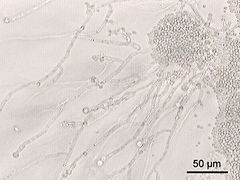Candida
Candida is a genus or grouping of yeasts. Yeasts are a type of fungus. This group of fungi are the most common cause of fungus infections in the world.[1] Most people have or are exposed to this group of fungus but are not sick. If a person is weak because of another illness, this fungus can cause disease.[2] Candida albicans is the most common kind of Candida. Infection with this fungus is called candidiasis or thrush. Other species in this group can be found in the human gut.[3]
| Candida | |
|---|---|

| |
| Candida albicans at 200× magnification | |
| Scientific classification | |
| Kingdom: | |
| Division: | |
| Class: | |
| Order: | |
| Family: | |
| Genus: | Candida Berkh. (1923)
|
| Type species | |
| Candida vulgaris Berkh. (1923)
| |
People can get a blood infection from this fungus.[4]
Medicines called antibiotics do not cure yeast infections. In fact, an antibiotic can make a Candida infection worse.[5] Women can get a Candida infection in their vagina. Men can also get a Candida infection in their genital area. If a person takes antibiotics for a long time, they have a greater chance of having a Candida infection. People with diabetes or HIV are more likely to get a yeast infection.[6][7]
Role as a pathogen change
This fungus can be grown in a lab. Candida looks like large, round, white or cream circles that smell like bread.[8] Candida can be found on almost all healthy skin.[9] Dry skin has less fungus.[10] Small numbers of this fungus are found in other areas of the body. These are the nose, throat and lungs; the digestive system and the vagina. This is normal.
When this fungus causes disease in the mouth it is called thrush (oropharyngeal candidiasis). When this fungus causes disease in the female reproductive organs it is called vaginal candidiasis or just 'yeast infection'. Thrush is common in people who wear dentures.[11]
Treatment change
In people without other illness, a candida infection can be cured with skin ointment or medicine that can be swallowed.[12] Skin medications can be bought over-the-counter without a doctor's prescription. In people who are already sick, candidiasis can become a very serious illness. It can cause abscess, thrombophlebitis, heart infection (endocarditis. It can cause infections of the eyes or other organs.[4][9] Candida infection can get into the body through cuts in the skin.[10]
Species change
Other medically important Candida species are C. parapsilosis, C. tropicalis, and C. dubliniensis.[4]
- C. albicans
- C. ascalaphidarum
- C. amphixiae
- C. antarctica
- C. argentea
- C. atlantica
- C. atmosphaerica
- C. auris
- C. blattae
- C. bracarensis
- C. bromeliacearum
- C. carpophila
- C. carvajalis[13]
- C. cerambycidarum
- C. chauliodes
- C. corydali
- C. dosseyi
- C. dubliniensis
- C. ergatensis
- C. fructus
- C. glabrata
- C. fermentati
- C. guilliermondii
- C. haemulonii
- C. humilis
- C. insectamens
- C. insectorum
- C. intermedia
- C. jeffresii
- C. kefyr
- C. keroseneae
- C. krusei
- C. lusitaniae
- C. lyxosophila
- C. maltosa
- C. marina
- C. membranifaciens
- C. mogii
- C. oleophila
- C. oregonensis
- C. parapsilosis
- C. quercitrusa
- C. rhizophoriensis
- C. rugosa
- C. sake
- C. sharkiensis
- C. shehatea
- C. temnochilae
- C. tenuis
- C. theae[14]
- C. tolerans
- C. tropicalis
- C. tsuchiyae
- C. sinolaborantium
- C. sojae
- C. subhashii
- C. viswanathii
- C. utilis
- C. ubatubensis
- C. zemplinina
References change
- ↑ Manolakaki, D., Velmahos, G., Kourkoumpetis, T., Chang, Y., Alam, H. B., De Moya, M. M., & Mylonakis, E. (2010). Candida infection and colonization among trauma patients. Virulence, 1(5), 367-375.
- ↑ Kourkoumpetis, Themistoklis K., | display-authors = etal "The effect of cumulative length of hospital stay on the antifungal resistance of Candida strains isolated from critically ill surgical patients." Mycopathologia 171.2 (2011): 85-91.
- ↑ Spanakis, Elias K., | display-authors = etal "Statin Therapy and Decreased Incidence of Positive< i> Candida</i> Cultures Among Patients With Type 2 Diabetes Mellitus Undergoing Gastrointestinal Surgery." Mayo Clinic Proceedings. Vol. 85. No. 12. Elsevier, 2010.
- ↑ 4.0 4.1 4.2 dEnfert C; Hube B, eds. (2007). Candida: Comparative and Functional Genomics. Caister Academic Press. ISBN 978-1-904455-13-4.
- ↑ Kennedy, MJ | display-authors = etal "Mechanisms of association of Candida albicans with intestinal mucosa", Med Microbiol, volume-24, 333-341, 1987
- ↑ Steckelberg, James M. (2012-09-18). "Male yeast infection: Can I get it from my girlfriend?". Mayo Clinic. Retrieved 2014-03-23.
- ↑ "Yeast Infections: MedlinePlus". Nlm.nih.gov. Retrieved 2014-03-23.
- ↑ "Candida species". DoctorFungus.org. Archived from the original on 2007-02-08. Retrieved 2007-02-09.
- ↑ 9.0 9.1 Jawetz; et al. (1978), "Medical Mycology", Review of Medical Microbiology (13th ed.), pp. 276–278
- ↑ 10.0 10.1 Goehring, Richard V. (2008). Mims' medical microbiology (4th ed.). Philadelphia, PA: Mosby Elsevier. p. 656. ISBN 9780323044752.
- ↑ Darwazeh A; Lamey P; Samaranayake L; MacFarlane T; et al. (1990). "The relationship between colonisation, secretor status and in-vitro adhesion of Candida albicans to buccal epithelial cells from diabetics". J Med Microbiol. 33 (1): 43–9. doi:10.1099/00222615-33-1-43. PMID 2231671.
- ↑ "Yeast Infections (Candidiasis) in Men and Women". WebMD. 2012-11-12. Retrieved 2014-03-23.
- ↑ James, S. A.; Carvajal Barriga, E. J.; Bond, C. J.; Cross, K.; Núñez, N. C.; Portero, P. B.; Roberts, I. N. (2009). "Candida carvajalissp. Nov., an ascomycetous yeast species from the Ecuadorian Amazon jungle". FEMS Yeast Research. 9 (5): 784–788. doi:10.1111/j.1567-1364.2009.00518.x. PMID 19459983.
- ↑ Chang, C. F.; Lin, Y. C.; Chen, S. F.; Carvajal Barriga, E. J.; Barahona, P. P.; James, S. A.; Bond, C. J.; Roberts, I. N.; Lee, C. F. (2012). "Candida theae sp. nov., a new anamorphic beverage-associated member of the Lodderomyces clade". International Journal of Food Microbiology. 153 (1–2): 10–14. doi:10.1016/j.ijfoodmicro.2011.09.012. PMID 22088606.
Other websites change
- Candida at the Encyclopedia of Life